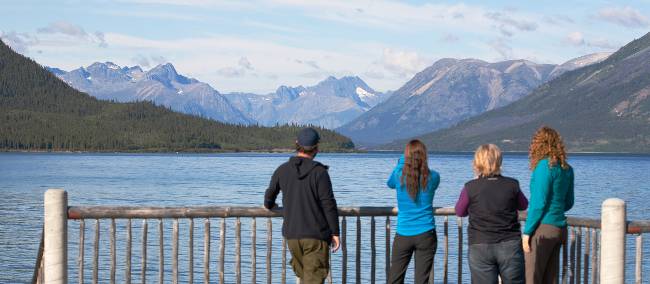
Mountain views on Bennett Lake near Carcross, YT | Mark Daffey
Blog home / Seeking fortune in the Yukon Territory
By Robin Esrock
In 2003, The Yukon Territory officially changed its name to Yukon Territory, dropping ‘the’ from all government usage. Yet decades later, most locals still refer to “the Yukon” and they have a good reason. According to the Merriam-Webster Dictionary, ‘the’ has many uses, among them: a function word before nouns that designate natural phenomena; points of a compass; a branch of human endeavour; and something best known and worth singling out. Call it Yukon all you want, but the Yukon easily meets those requirements.
The Yukon Territory has long attracted its share of dreamers: countless caribou dreaming of rich grazing in wind-carved valleys beneath the shadow of granite mountains; ambitious prospectors seeking their fortune in the glittering rivers of the Klondike; and more recently, outdoor enthusiasts from around the world, dreaming of unparalleled backcountry adventure, and the very best hiking in Canada. This untamed wilderness is populated by legends of northern wildlife – bears, moose, caribou, Dall sheep, wolves – and cultures that live, breathe and thrive beneath both midnight sun and glowing aurora skies. The territory’s unusual combination of gold-rush history and pristine scenery is unforgettable, whether you find yourself day-hiking beneath the granite pinnacles of Tombstone mountain, exploring the sinking storefronts of Dawson City, soaking in the Takhini Hot Springs, or soaring above the world’s largest non-polar icefields in a floatplane or helicopter. Relics of the past rust along the Chilkoot Trail hike, while animals graze in sweeping valleys and wildflower-rich meadows. This is the North in all its glory, and with all its eccentricities too.

Every Yukon adventure inevitably flows through the capital of Whitehorse. The territory’s capital is the largest city in the north, and you might notice its character before you leave the airport: spot the decommissioned DC-3 serving as a weather vane? You can feast on wild salmon in food shacks or inside hip bistros, shop for curios in buzzing stores and street markets, or rent a bike and pedal 700km/435mi of city trails. Yet any Yukon adventure will undoubtedly leave the frontier capital behind to explore a vast landscape that stretches from the north of British Columbia to the Beaufort Sea. Blessed with 17 of the 20 tallest mountains in Canada, the Yukon is bigger than Germany, Austria and Switzerland combined. And if 100 million people call those three countries home, consider that just 35,000 people live in the Yukon (75% of whom call Whitehorse their home). Soon enough you’ll find yourself amidst old-growth boreal forests while hiking the Chilkoot Trail, or struggling for superlatives on the Tombstone Range hike, grappling with a sense of being lost in the last great unspoiled wilderness on Earth. Handy, then, to have everything you need on your back, and even better to enjoy food drops and be in the company of an experienced local wilderness guide.

The Yukon’s cultural history is a cocktail of three parts. It starts with the First Nations who have called this rugged land home for millennia. Then came the hardened, mostly destitute but occasionally fortunate Stampeders, flooding the Klondike in the late 19th-century gold rush, transforming ramshackle Dawson City into the most populous city north of San Francisco. Today’s sourdoughs – locals-only earn the moniker after enduring many winters - embrace the freedoms and challenges of life above the 60th parallel. Legends and myths, fables and odes, there’s a distinct spirit in the land, water and sky. There’s also mischief in the saloons (just Google the Sour Toe Cocktail and you’ll see what we’re talking about). Yes, there’s a sense up here that anything goes, and with so much land to access, more than enough to go around. Even so, the land still needs protection and responsible stewardship. Iconic parks like Ivvavik, Tombstone and Vuntut ensure massive swarths of the territory remain unique and untouched, while the glaciers and ranges within Kluane National Park and Reserve enjoy UNESCO World Heritage status. Limits and quotas restrict hikers entering the legendary Chilkoot Trail, ensuring the environment remains intact, and the visitor experience extraordinary.
Great Canadian Trails offers three unforgettable adventures in the Yukon, making the most iconic hikes and outdoor experiences in the territory more accessible than ever. The Yukon, or simply Yukon if you prefer, awaits your arrival.